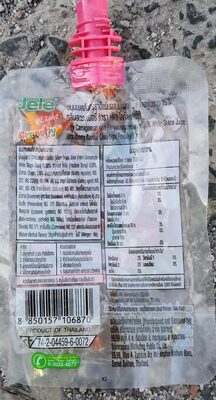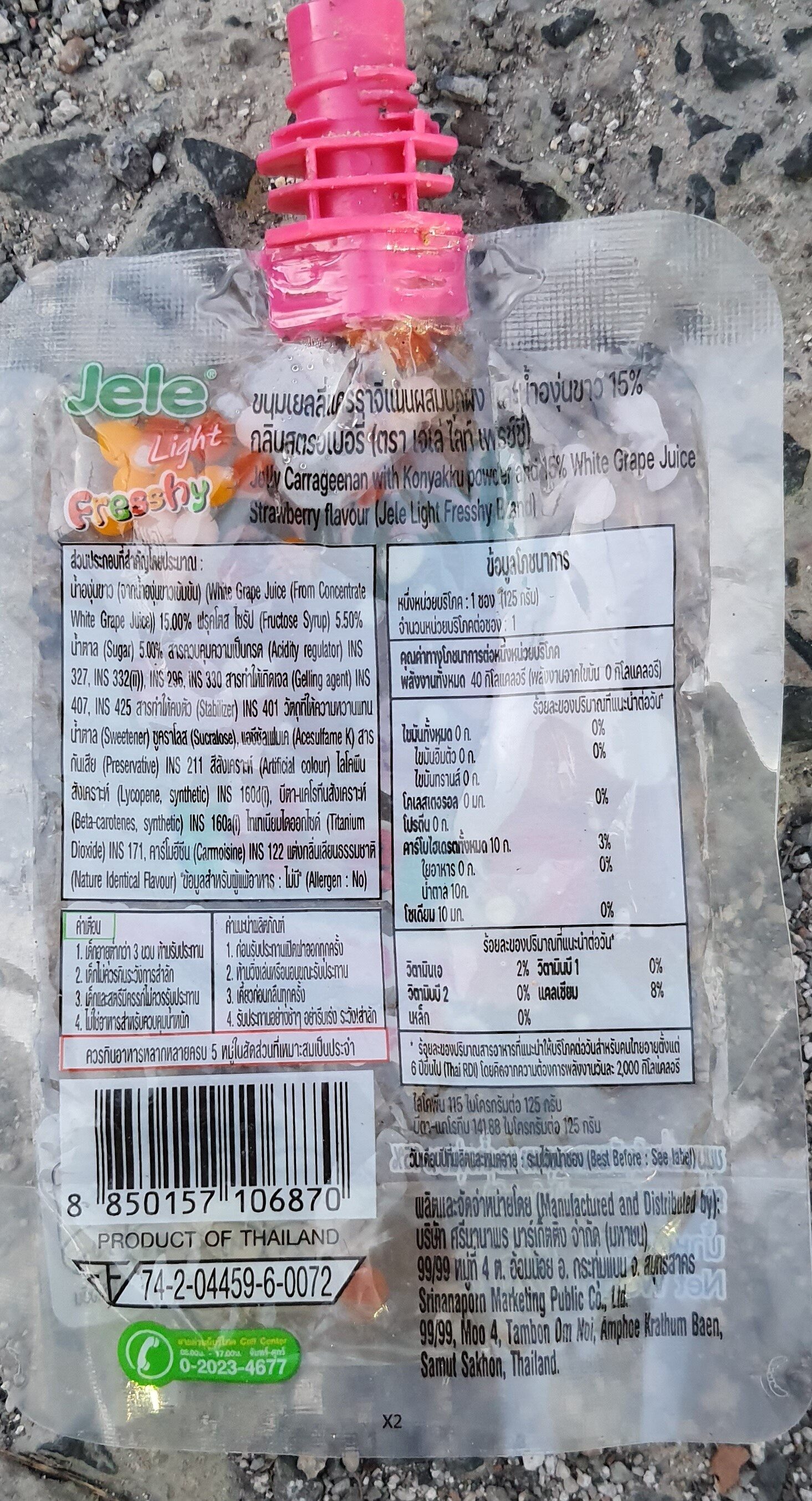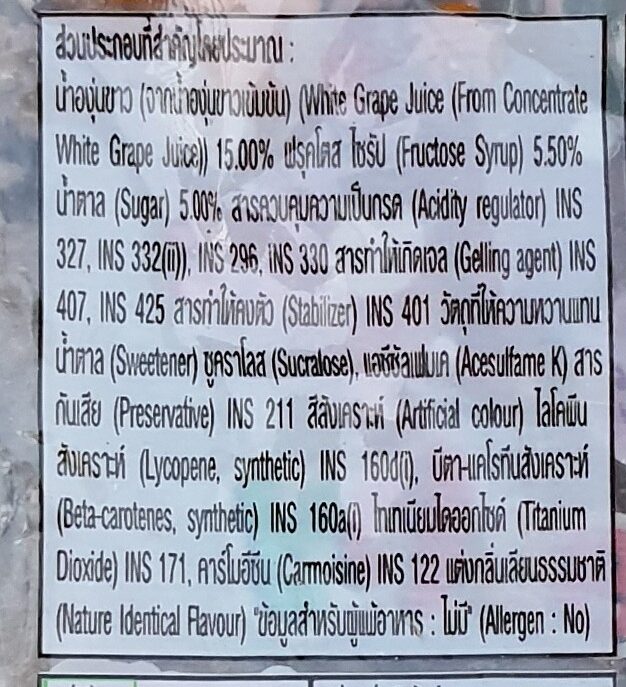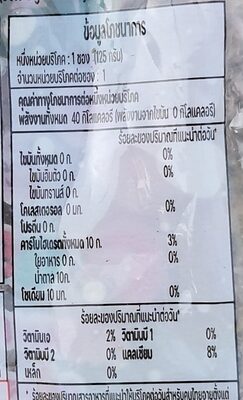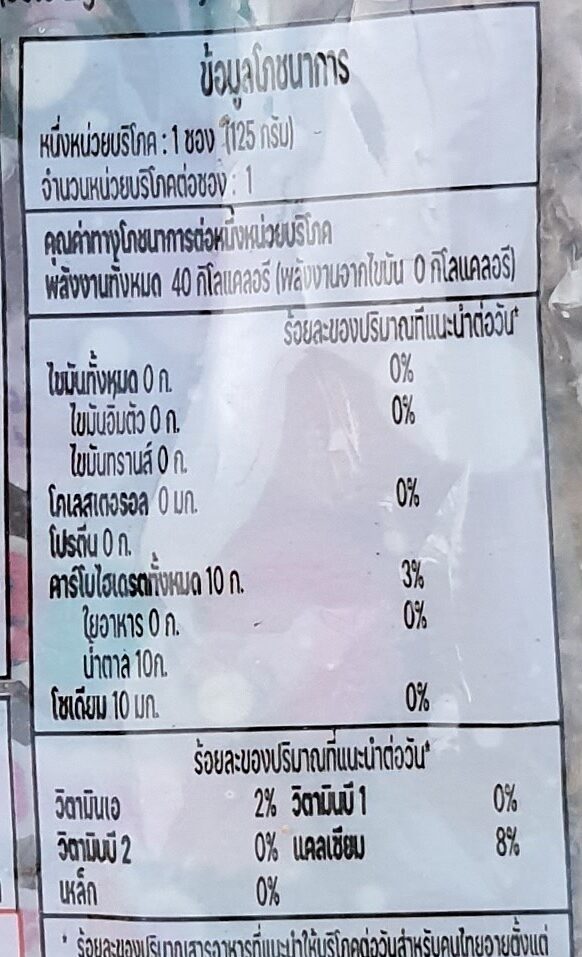Help us make food transparency the norm!
As a non-profit organization, we depend on your donations to continue informing consumers around the world about what they eat.
The food revolution starts with you!
เจเล่ ไลท์ เฟรช์ชี่ - Jele - 125 g
เจเล่ ไลท์ เฟรช์ชี่ - Jele - 125 g
This product page is not complete. You can help to complete it by editing it and adding more data from the photos we have, or by taking more photos using the app for Android or iPhone/iPad. Thank you!
×
Barcode: 8850157106870 (EAN / EAN-13)
Common name: ขนมเจลลี่อคร์ราจีแนนผสมบุกผง
Quantity: 125 g
Packaging: Plastic
Categories: Plant-based foods and beverages, Plant-based foods, Snacks, Breakfasts, Spreads, Sweet snacks, Plant-based spreads, Sweet spreads, Fruit and vegetable preserves, Fruit jellies
Countries where sold: Thailand
Matching with your preferences
Health
Ingredients
-
50 ingredients
Thai: ส่วนประกอบที่สำคัญโดยประมาณ : น้ำองุ่นขาว (จากน้ำองุ่นขาวบัมบัน) (White Grape Juice (From Concentrate White Grape Juice)) 15.00% ฟรุคโตส ไซรัป (Fructose Syrup) 5.50% น้ำตาล (Sugar) 5,00% สารควบคุมความเป็นกรด (Acidity regulator) INS 327, INS 332(1), INS 296, INS 330 ansṁliñada (Gelling agent) INS 407, INS 425 สารทำให้คงตัว (Stabilizer) INS 401 วัตถุที่ให้ความหวานแทน น้ำตาล (Sweetener) ซูคราโลส (Sucralose), แอซีซัลเฟมเค (Acesulfame K) สาร กันเสีย (Preservative) INS 211 สีสังเคราะห์ (Artificial colour) ไลโคพีน สังเคราะห์ (Lycopene, Synthetic) INS 16000), บีตา-แคโรทีมสังเคราะห์ (Beta-carotenes, synthetic) INS 160 (1) Truทเนียมไดออกไซด์ (Titanium Dioxide) INS 171, คาร์ไมอีซีน (Carmoisine) INS 122 แต่งกลิ่นเลียนธรรมชาติ (Nature Identical Flavour) ข้อมูลสำหรับผู้แพ้อาหาร : ไม่มี” (Allergen : No)
Food processing
-
Ultra processed foods
Elements that indicate the product is in the 4 - Ultra processed food and drink products group:
- Additive: E160a - Carotene
- Additive: E160d - Lycopene
- Additive: E171 - Titanium dioxide
- Additive: E955 - Sucralose
Food products are classified into 4 groups according to their degree of processing:
- Unprocessed or minimally processed foods
- Processed culinary ingredients
- Processed foods
- Ultra processed foods
The determination of the group is based on the category of the product and on the ingredients it contains.
Additives
-
E160a - Carotene
Carotene: The term carotene -also carotin, from the Latin carota, "carrot"- is used for many related unsaturated hydrocarbon substances having the formula C40Hx, which are synthesized by plants but in general cannot be made by animals -with the exception of some aphids and spider mites which acquired the synthesizing genes from fungi-. Carotenes are photosynthetic pigments important for photosynthesis. Carotenes contain no oxygen atoms. They absorb ultraviolet, violet, and blue light and scatter orange or red light, and -in low concentrations- yellow light. Carotenes are responsible for the orange colour of the carrot, for which this class of chemicals is named, and for the colours of many other fruits, vegetables and fungi -for example, sweet potatoes, chanterelle and orange cantaloupe melon-. Carotenes are also responsible for the orange -but not all of the yellow- colours in dry foliage. They also -in lower concentrations- impart the yellow coloration to milk-fat and butter. Omnivorous animal species which are relatively poor converters of coloured dietary carotenoids to colourless retinoids have yellowed-coloured body fat, as a result of the carotenoid retention from the vegetable portion of their diet. The typical yellow-coloured fat of humans and chickens is a result of fat storage of carotenes from their diets. Carotenes contribute to photosynthesis by transmitting the light energy they absorb to chlorophyll. They also protect plant tissues by helping to absorb the energy from singlet oxygen, an excited form of the oxygen molecule O2 which is formed during photosynthesis. β-Carotene is composed of two retinyl groups, and is broken down in the mucosa of the human small intestine by β-carotene 15‚15'-monooxygenase to retinal, a form of vitamin A. β-Carotene can be stored in the liver and body fat and converted to retinal as needed, thus making it a form of vitamin A for humans and some other mammals. The carotenes α-carotene and γ-carotene, due to their single retinyl group -β-ionone ring-, also have some vitamin A activity -though less than β-carotene-, as does the xanthophyll carotenoid β-cryptoxanthin. All other carotenoids, including lycopene, have no beta-ring and thus no vitamin A activity -although they may have antioxidant activity and thus biological activity in other ways-. Animal species differ greatly in their ability to convert retinyl -beta-ionone- containing carotenoids to retinals. Carnivores in general are poor converters of dietary ionone-containing carotenoids. Pure carnivores such as ferrets lack β-carotene 15‚15'-monooxygenase and cannot convert any carotenoids to retinals at all -resulting in carotenes not being a form of vitamin A for this species-; while cats can convert a trace of β-carotene to retinol, although the amount is totally insufficient for meeting their daily retinol needs.Source: Wikipedia
-
E160ai - Beta-carotene
Beta-Carotene: β-Carotene is an organic, strongly colored red-orange pigment abundant in plants and fruits. It is a member of the carotenes, which are terpenoids -isoprenoids-, synthesized biochemically from eight isoprene units and thus having 40 carbons. Among the carotenes, β-carotene is distinguished by having beta-rings at both ends of the molecule. β-Carotene is biosynthesized from geranylgeranyl pyrophosphate.β-Carotene is the most common form of carotene in plants. When used as a food coloring, it has the E number E160a. The structure was deduced by Karrer et al. in 1930. In nature, β-carotene is a precursor -inactive form- to vitamin A via the action of beta-carotene 15‚15'-monooxygenase.Isolation of β-carotene from fruits abundant in carotenoids is commonly done using column chromatography. It can also be extracted from the beta-carotene rich algae, Dunaliella salina. The separation of β-carotene from the mixture of other carotenoids is based on the polarity of a compound. β-Carotene is a non-polar compound, so it is separated with a non-polar solvent such as hexane. Being highly conjugated, it is deeply colored, and as a hydrocarbon lacking functional groups, it is very lipophilic.Source: Wikipedia
-
E160d - Lycopene
Lycopene: Lycopene -from the neo-Latin Lycopersicum, the tomato species- is a bright red carotene and carotenoid pigment and phytochemical found in tomatoes and other red fruits and vegetables, such as red carrots, watermelons, gac, and papayas, but it is not in strawberries or cherries. Although lycopene is chemically a carotene, it has no vitamin A activity. Foods that are not red may also contain lycopene, such as asparagus and parsley.In plants, algae, and other photosynthetic organisms, lycopene is an intermediate in the biosynthesis of many carotenoids, including beta-carotene, which is responsible for yellow, orange, or red pigmentation, photosynthesis, and photoprotection. Like all carotenoids, lycopene is a tetraterpene. It is insoluble in water. Eleven conjugated double bonds give lycopene its deep red color. Owing to the strong color, lycopene is useful as a food coloring -registered as E160d- and is approved for use in the USA, Australia and New Zealand -registered as 160d- and the European Union.Source: Wikipedia
-
E171 - Titanium dioxide
Titanium dioxide: Titanium dioxide, also known as titaniumIV oxide or titania, is the naturally occurring oxide of titanium, chemical formula TiO2. When used as a pigment, it is called titanium white, Pigment White 6 -PW6-, or CI 77891. Generally, it is sourced from ilmenite, rutile and anatase. It has a wide range of applications, including paint, sunscreen and food coloring. When used as a food coloring, it has E number E171. World production in 2014 exceeded 9 million metric tons. It has been estimated that titanium dioxide is used in two-thirds of all pigments, and the oxide has been valued at $13.2 billion.Source: Wikipedia
-
E296 - Malic acid
Malic acid: Malic acid is an organic compound with the molecular formula C4H6O5. It is a dicarboxylic acid that is made by all living organisms, contributes to the pleasantly sour taste of fruits, and is used as a food additive. Malic acid has two stereoisomeric forms -L- and D-enantiomers-, though only the L-isomer exists naturally. The salts and esters of malic acid are known as malates. The malate anion is an intermediate in the citric acid cycle.Source: Wikipedia
-
E332 - Potassium citrates
Potassium citrate: Potassium citrate -also known as tripotassium citrate- is a potassium salt of citric acid with the molecular formula K3C6H5O7. It is a white, hygroscopic crystalline powder. It is odorless with a saline taste. It contains 38.28% potassium by mass. In the monohydrate form it is highly hygroscopic and deliquescent. As a food additive, potassium citrate is used to regulate acidity and is known as E number E332. Medicinally, it may be used to control kidney stones derived from either uric acid or cystine.Source: Wikipedia
-
E955 - Sucralose
Sucralose: Sucralose is an artificial sweetener and sugar substitute. The majority of ingested sucralose is not broken down by the body, so it is noncaloric. In the European Union, it is also known under the E number E955. It is produced by chlorination of sucrose. Sucralose is about 320 to 1‚000 times sweeter than sucrose, three times as sweet as both aspartame and acesulfame potassium, and twice as sweet as sodium saccharin. Evidence of benefit is lacking for long-term weight loss with some data supporting weight gain and heart disease risks.It is stable under heat and over a broad range of pH conditions. Therefore, it can be used in baking or in products that require a long shelf life. The commercial success of sucralose-based products stems from its favorable comparison to other low-calorie sweeteners in terms of taste, stability, and safety. Common brand names of sucralose-based sweeteners are Splenda, Zerocal, Sukrana, SucraPlus, Candys, Cukren, and Nevella. Canderel Yellow also contains sucralose, but the original Canderel and Green Canderel do not.Source: Wikipedia
Ingredients analysis
-
Palm oil content unknown
Unrecognized ingredients: th:ส่วนประกอบที่สำคัญโดยประมาณ, th:น้ำองุ่นขาว, th:จากน้ำองุ่นขาวบัมบัน, th:white-grape-juice, th:from-concentrate-white-grape-juice, th:ฟรุคโตส-ไซรัป, th:fructose-syrup, th:sugar, th:สารควบคุมความเป็นกรด, th:acidity-regulator, th:1, th:e330-ansṁliñada, th:gelling-agent, th:e425-สารทำให้คงตัว, th:stabilizer, th:e401-วัตถุที่ให้ความหวานแทน-น้ำตาล, th:sweetener, th:ซูคราโลส, th:sucralose, th:แอซีซัลเฟมเค, th:acesulfame-k, th:สาร-กันเสีย, th:preservative, th:e211-สีสังเคราะห์, th:artificial-colour, th:ไลโคพีน-สังเคราะห์, th:lycopene, th:synthetic, th:e16000, th:บีตา-แคโรทีมสังเคราะห์, th:beta-carotenes, th:synthetic, th:1, th:truทเนียมไดออกไซด์, th:titanium-dioxide, th:คาร์ไมอีซีน, th:carmoisine, th:e122-แต่งกลิ่นเลียนธรรมชาติ, th:nature-identical-flavour, th:ข้อมูลสำหรับผู้แพ้อาหาร, th:ไม่มี, th:allergen, th:noSome ingredients could not be recognized.
We need your help!
You can help us recognize more ingredients and better analyze the list of ingredients for this product and others:
- Edit this product page to correct spelling mistakes in the ingredients list, and/or to remove ingredients in other languages and sentences that are not related to the ingredients.
- Add new entries, synonyms or translations to our multilingual lists of ingredients, ingredient processing methods, and labels.
If you would like to help, join the #ingredients channel on our Slack discussion space and/or learn about ingredients analysis on our wiki. Thank you!
-
Vegan status unknown
Unrecognized ingredients: th:ส่วนประกอบที่สำคัญโดยประมาณ, th:น้ำองุ่นขาว, th:จากน้ำองุ่นขาวบัมบัน, th:white-grape-juice, th:from-concentrate-white-grape-juice, th:ฟรุคโตส-ไซรัป, th:fructose-syrup, th:sugar, th:สารควบคุมความเป็นกรด, th:acidity-regulator, th:1, th:e330-ansṁliñada, th:gelling-agent, th:e425-สารทำให้คงตัว, th:stabilizer, th:e401-วัตถุที่ให้ความหวานแทน-น้ำตาล, th:sweetener, th:ซูคราโลส, th:sucralose, th:แอซีซัลเฟมเค, th:acesulfame-k, th:สาร-กันเสีย, th:preservative, th:e211-สีสังเคราะห์, th:artificial-colour, th:ไลโคพีน-สังเคราะห์, th:lycopene, th:synthetic, th:e16000, th:บีตา-แคโรทีมสังเคราะห์, th:beta-carotenes, th:synthetic, th:1, th:truทเนียมไดออกไซด์, th:titanium-dioxide, th:คาร์ไมอีซีน, th:carmoisine, th:e122-แต่งกลิ่นเลียนธรรมชาติ, th:nature-identical-flavour, th:ข้อมูลสำหรับผู้แพ้อาหาร, th:ไม่มี, th:allergen, th:noSome ingredients could not be recognized.
We need your help!
You can help us recognize more ingredients and better analyze the list of ingredients for this product and others:
- Edit this product page to correct spelling mistakes in the ingredients list, and/or to remove ingredients in other languages and sentences that are not related to the ingredients.
- Add new entries, synonyms or translations to our multilingual lists of ingredients, ingredient processing methods, and labels.
If you would like to help, join the #ingredients channel on our Slack discussion space and/or learn about ingredients analysis on our wiki. Thank you!
-
Vegetarian status unknown
Unrecognized ingredients: th:ส่วนประกอบที่สำคัญโดยประมาณ, th:น้ำองุ่นขาว, th:จากน้ำองุ่นขาวบัมบัน, th:white-grape-juice, th:from-concentrate-white-grape-juice, th:ฟรุคโตส-ไซรัป, th:fructose-syrup, th:sugar, th:สารควบคุมความเป็นกรด, th:acidity-regulator, th:1, th:e330-ansṁliñada, th:gelling-agent, th:e425-สารทำให้คงตัว, th:stabilizer, th:e401-วัตถุที่ให้ความหวานแทน-น้ำตาล, th:sweetener, th:ซูคราโลส, th:sucralose, th:แอซีซัลเฟมเค, th:acesulfame-k, th:สาร-กันเสีย, th:preservative, th:e211-สีสังเคราะห์, th:artificial-colour, th:ไลโคพีน-สังเคราะห์, th:lycopene, th:synthetic, th:e16000, th:บีตา-แคโรทีมสังเคราะห์, th:beta-carotenes, th:synthetic, th:1, th:truทเนียมไดออกไซด์, th:titanium-dioxide, th:คาร์ไมอีซีน, th:carmoisine, th:e122-แต่งกลิ่นเลียนธรรมชาติ, th:nature-identical-flavour, th:ข้อมูลสำหรับผู้แพ้อาหาร, th:ไม่มี, th:allergen, th:noSome ingredients could not be recognized.
We need your help!
You can help us recognize more ingredients and better analyze the list of ingredients for this product and others:
- Edit this product page to correct spelling mistakes in the ingredients list, and/or to remove ingredients in other languages and sentences that are not related to the ingredients.
- Add new entries, synonyms or translations to our multilingual lists of ingredients, ingredient processing methods, and labels.
If you would like to help, join the #ingredients channel on our Slack discussion space and/or learn about ingredients analysis on our wiki. Thank you!
-
Details of the analysis of the ingredients
We need your help!
Some ingredients could not be recognized.
We need your help!
You can help us recognize more ingredients and better analyze the list of ingredients for this product and others:
- Edit this product page to correct spelling mistakes in the ingredients list, and/or to remove ingredients in other languages and sentences that are not related to the ingredients.
- Add new entries, synonyms or translations to our multilingual lists of ingredients, ingredient processing methods, and labels.
If you would like to help, join the #ingredients channel on our Slack discussion space and/or learn about ingredients analysis on our wiki. Thank you!
th: ส่วนประกอบที่สำคัญโดยประมาณ (น้ำองุ่นขาว (จากน้ำองุ่นขาวบัมบัน, White Grape Juice (From Concentrate White Grape Juice)), ฟรุคโตส ไซรัป 15% (Fructose Syrup), น้ำตาล 5.5% (Sugar), สารควบคุมความเป็นกรด 5% (Acidity regulator), e327), e332 (1), e296, e330 ansṁliñada (Gelling agent), e407, e425 สารทำให้คงตัว (Stabilizer), e401 วัตถุที่ให้ความหวานแทน น้ำตาล (Sweetener), ซูคราโลส (Sucralose), แอซีซัลเฟมเค (Acesulfame K), สาร กันเสีย (Preservative), e211 สีสังเคราะห์ (Artificial colour), ไลโคพีน สังเคราะห์ (Lycopene, Synthetic), E16000, บีตา-แคโรทีมสังเคราะห์ (Beta-carotenes, synthetic), e160 (1), Truทเนียมไดออกไซด์ (Titanium Dioxide), e171, คาร์ไมอีซีน (Carmoisine), e122 แต่งกลิ่นเลียนธรรมชาติ (Nature Identical Flavour), ข้อมูลสำหรับผู้แพ้อาหาร (ไม่มี”, Allergen), No- ส่วนประกอบที่สำคัญโดยประมาณ -> th:ส่วนประกอบที่สำคัญโดยประมาณ
- น้ำองุ่นขาว -> th:น้ำองุ่นขาว
- จากน้ำองุ่นขาวบัมบัน -> th:จากน้ำองุ่นขาวบัมบัน
- White Grape Juice -> th:white-grape-juice
- From Concentrate White Grape Juice -> th:from-concentrate-white-grape-juice
- ฟรุคโตส ไซรัป -> th:ฟรุคโตส-ไซรัป - percent: 15
- Fructose Syrup -> th:fructose-syrup
- น้ำตาล -> en:sugar - vegan: yes - vegetarian: yes - ciqual_proxy_food_code: 31016 - percent: 5.5
- Sugar -> th:sugar
- สารควบคุมความเป็นกรด -> th:สารควบคุมความเป็นกรด - percent: 5
- Acidity regulator -> th:acidity-regulator
- e327 -> en:e327 - vegan: yes - vegetarian: yes
- น้ำองุ่นขาว -> th:น้ำองุ่นขาว
- e332 -> en:e332 - vegan: yes - vegetarian: yes
- 1 -> th:1
- e296 -> en:e296 - vegan: yes - vegetarian: yes
- e330 ansṁliñada -> th:e330-ansṁliñada
- Gelling agent -> th:gelling-agent
- e407 -> en:e407 - vegan: yes - vegetarian: yes
- e425 สารทำให้คงตัว -> th:e425-สารทำให้คงตัว
- Stabilizer -> th:stabilizer
- e401 วัตถุที่ให้ความหวานแทน น้ำตาล -> th:e401-วัตถุที่ให้ความหวานแทน-น้ำตาล
- Sweetener -> th:sweetener
- ซูคราโลส -> th:ซูคราโลส
- Sucralose -> th:sucralose
- แอซีซัลเฟมเค -> th:แอซีซัลเฟมเค
- Acesulfame K -> th:acesulfame-k
- สาร กันเสีย -> th:สาร-กันเสีย
- Preservative -> th:preservative
- e211 สีสังเคราะห์ -> th:e211-สีสังเคราะห์
- Artificial colour -> th:artificial-colour
- ไลโคพีน สังเคราะห์ -> th:ไลโคพีน-สังเคราะห์
- Lycopene -> th:lycopene
- Synthetic -> th:synthetic
- E16000 -> th:e16000
- บีตา-แคโรทีมสังเคราะห์ -> th:บีตา-แคโรทีมสังเคราะห์
- Beta-carotenes -> th:beta-carotenes
- synthetic -> th:synthetic
- e160 -> en:e160 - vegan: maybe - vegetarian: maybe
- 1 -> th:1
- Truทเนียมไดออกไซด์ -> th:truทเนียมไดออกไซด์
- Titanium Dioxide -> th:titanium-dioxide
- e171 -> en:e171 - vegan: yes - vegetarian: yes
- คาร์ไมอีซีน -> th:คาร์ไมอีซีน
- Carmoisine -> th:carmoisine
- e122 แต่งกลิ่นเลียนธรรมชาติ -> th:e122-แต่งกลิ่นเลียนธรรมชาติ
- Nature Identical Flavour -> th:nature-identical-flavour
- ข้อมูลสำหรับผู้แพ้อาหาร -> th:ข้อมูลสำหรับผู้แพ้อาหาร
- ไม่มี” -> th:ไม่มี
- Allergen -> th:allergen
- No -> th:no
Nutrition
-
Missing data to compute the Nutri-Score
Missing nutrition facts
⚠ ️The nutrition facts of the product must be specified in order to compute the Nutri-Score.Could you add the information needed to compute the Nutri-Score? Add nutrition facts
-
Nutrition facts
Nutrition facts As sold
per serving (125)Compared to: Fruit jellies Energy 167 kj
(40 kcal)Fat 0 g Saturated fat 0 g Carbohydrates 10 g Sugars 10 g Fiber 0 g Proteins 0 g Salt 0 g Vitamin A 30 µg (2 % DV) Vitamin B1 (Thiamin) 0 mg (0 % DV) Vitamin B2 (Riboflavin) 0 mg (0 % DV) Calcium 80 mg (8 % DV) Iron 0 mg (0 % DV) Fruits‚ vegetables‚ nuts and rapeseed‚ walnut and olive oils (estimate from ingredients list analysis) 0 %
Environment
-
Eco-Score B - Low environmental impact
⚠ ️Select a country in order to include the full impact of transportation.The Eco-Score is an experimental score that summarizes the environmental impacts of food products.→ The Eco-Score was initially developped for France and it is being extended to other European countries. The Eco-Score formula is subject to change as it is regularly improved to make it more precise and better suited to each country.Life cycle analysis
-
Average impact of products of the same category: A (Score: 80/100)
Category: Jam, strawberry
Category: Jam, strawberry
- PEF environmental score: 0.27 (the lower the score, the lower the impact)
- including impact on climate change: 1.42 kg CO2 eq/kg of product
Stage Impact Agriculture
53.9 %Processing
14.3 %Packaging
20.4 %Transportation
8.7 %Distribution
1.8 %Consumption
0.9 %
Bonuses and maluses
-
Missing origins of ingredients information
Malus: -5
⚠ ️ The origins of the ingredients of this product are not indicated.
If they are indicated on the packaging, you can modify the product sheet and add them.
If you are the manufacturer of this product, you can send us the information with our free platform for producers.
-
Packaging with a medium impact
Malus: -10
Shape Material Recycling Impact Unknown Plastic High ⚠ ️ The information about the packaging of this product is not sufficiently precise (exact shapes and materials of all components of the packaging).⚠ ️ For a more precise calculation of the Eco-Score, you can modify the product page and add them.
If you are the manufacturer of this product, you can send us the information with our free platform for producers.
Eco-Score for this product
-
Impact for this product: B (Score: 65/100)
Product: เจเล่ ไลท์ เฟรช์ชี่ - Jele - 125 g
Life cycle analysis score: 80
Sum of bonuses and maluses: -15
Final score: 65/100
-
Carbon footprint
-
Equal to driving 0.7 km in a petrol car
142 g CO² per 100g of product
The carbon emission figure comes from ADEME's Agribalyse database, for the category: Jam, strawberry (Source: ADEME Agribalyse Database)
Stage Impact Agriculture
23.1 %Processing
17.7 %Packaging
37.0 %Transportation
20.2 %Distribution
1.4 %Consumption
0.5 %
Packaging
-
Packaging with a medium impact
-
Packaging parts
(Plastic)
-
Packaging materials
Material % Packaging weight Packaging weight per 100 g of product Plastic
-
Transportation
-
Origins of ingredients
Missing origins of ingredients information
⚠ ️ The origins of the ingredients of this product are not indicated.
If they are indicated on the packaging, you can modify the product sheet and add them.
If you are the manufacturer of this product, you can send us the information with our free platform for producers.Add the origins of ingredients for this product Add the origins of ingredients for this product
Report a problem
-
Incomplete or incorrect information?
Category, labels, ingredients, allergens, nutritional information, photos etc.
If the information does not match the information on the packaging, please complete or correct it. Open Food Facts is a collaborative database, and every contribution is useful for all.
